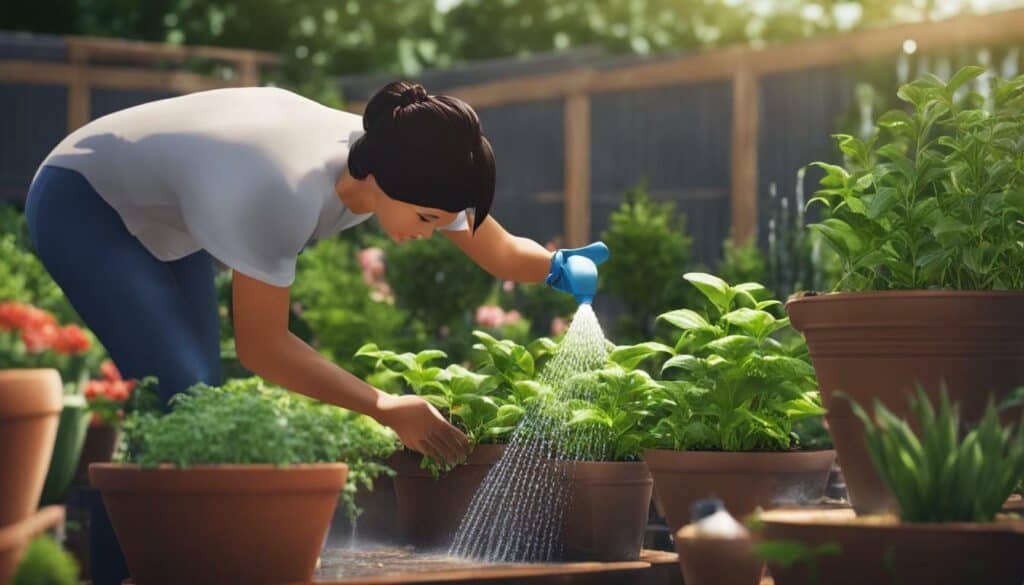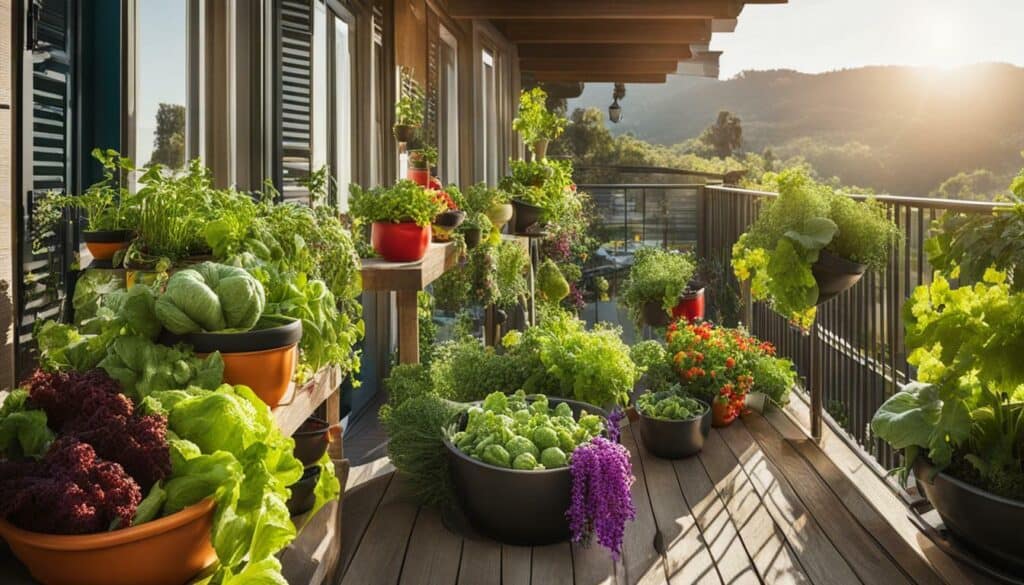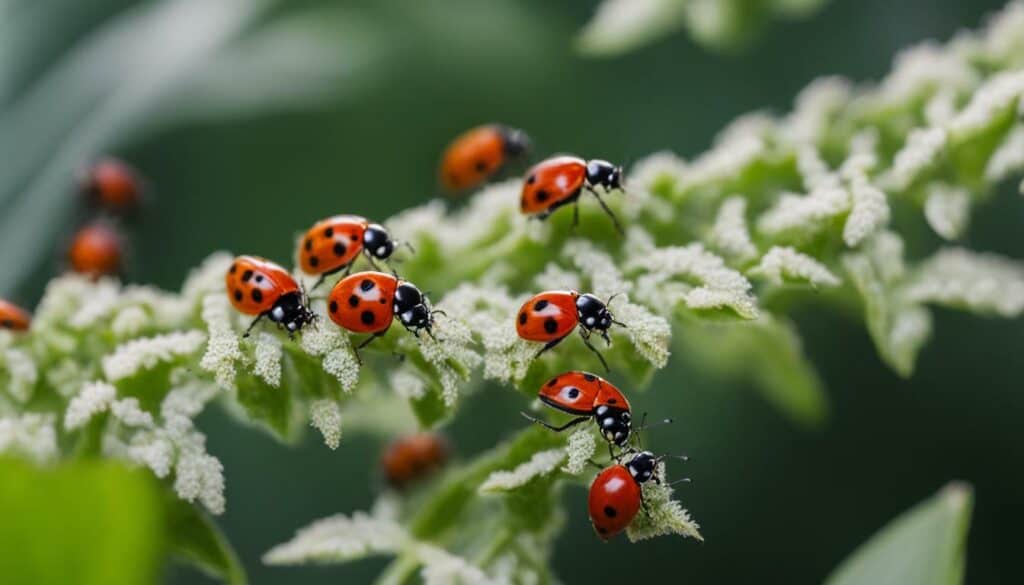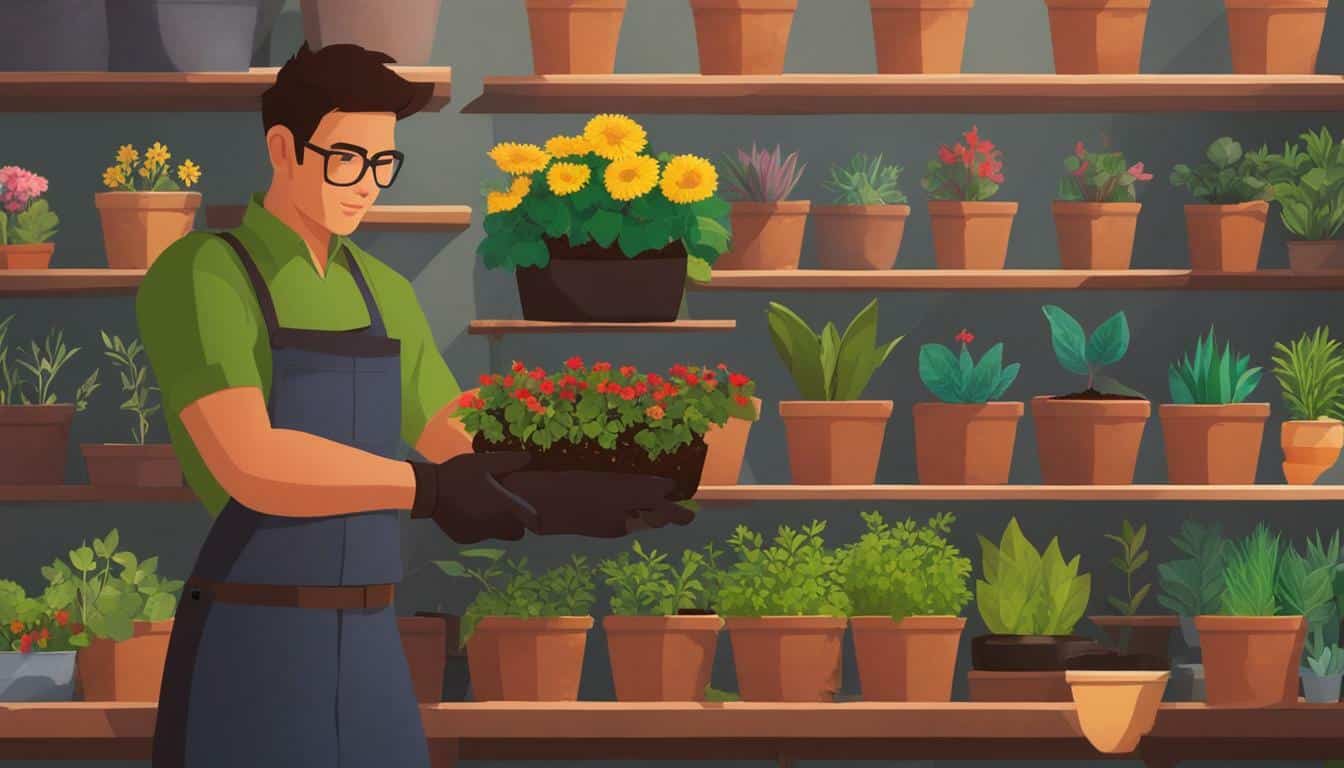Welcome to Planter Gardening 101: your friendly beginner’s guide to growing a thriving garden from planters. Whether you have limited space or simply want to add a touch of green to your home, planter gardening is the perfect solution. This guide will take you through the essentials of planter gardening, from understanding your gardening goals to selecting the right plants, planting techniques, and nurturing your plants for optimal growth. Get ready to embark on a rewarding journey of cultivating your own green thumb!
Key Takeaways:
- Planter gardening is a great option for those with limited space or looking to add greenery to their homes.
- Understanding your gardening goals and setting clear objectives will help you plan and execute your garden effectively.
- Choosing the right plants based on sunlight and water requirements is crucial for the success of your planter garden.
- Proper planting techniques, such as using quality potting soil and arranging plants strategically, will ensure healthy growth.
- Consistent watering, irrigation, and fertilization are essential for nurturing your plants and promoting optimal growth.
Understanding Gardening Goals
Before diving into the world of planter gardening, it’s essential to understand your gardening goals and aspirations. Whether you’re looking to create a beautiful outdoor oasis, grow your own fruits and vegetables, or simply enjoy the therapeutic benefits of nurturing plants, defining your objectives will help guide your gardening journey.
Start by considering the space you have available for your planter garden. Are you working with a small balcony, a spacious backyard, or even an indoor area? The size and location of your garden will influence the types of plants you can grow and the techniques you’ll need to employ.
Next, think about the level of commitment you’re willing to invest in your plants. Are you seeking a low-maintenance garden that requires minimal care, or are you excited about dedicating time and effort to cultivate a thriving oasis? Understanding your preferred level of involvement will help you choose the right plants and determine the amount of time you’ll need to dedicate to your planter garden.
Lastly, consider your personal preferences and interests. Are you passionate about growing your own food? Do you have a particular affinity for flowers or herbs? Identifying the types of plants that bring you joy and align with your interests will make the gardening experience even more fulfilling.
Selecting the Right Plants for Your Planters
Choosing the right plants is crucial for successful planter gardening, as it will determine the overall health and aesthetics of your garden. When selecting plants for your planters, consider factors such as sunlight requirements, water needs, and the size of your containers.
To ensure your plants thrive, it’s essential to understand their sunlight requirements. Some plants prefer full sun, while others thrive in partial shade. Take note of the amount of sunlight your planter area receives throughout the day and choose plants accordingly. For example, if you have a sunny spot, you might opt for vibrant flowers like petunias or marigolds, while ferns and ivy can add a touch of greenery to a shady corner.
Water needs vary among different plants, so it’s important to choose ones that align with the watering routine you can commit to. Succulents, such as jade plants or aloe vera, have low water requirements and are great options for busy individuals or those with a tendency to overwater. On the other hand, plants like tomatoes or herbs may require more frequent watering.
Here’s a list of plants suitable for planter gardening:
- Herbs: Rosemary, basil, mint
- Flowers: Geraniums, pansies, impatiens
- Vegetables: Tomatoes, peppers, lettuce
- Succulents: Aloe vera, jade plants, sedums
- Greenery: Ferns, ivy, spider plants
Remember to consider the size of your planters when selecting plants. Some plants, like tomatoes or larger herbs, require deeper containers to accommodate their root systems. If space is limited, consider vertical gardening options using hanging baskets or trellises, which can maximize your planting area.
| Plant | Sunlight Requirements | Water Needs |
|---|---|---|
| Rosemary | Full sun | Low |
| Basil | Full sun | Medium |
| Mint | Partial shade | High |
| Geraniums | Full sun | Medium |
| Pansies | Partial shade | Medium |
| Impatiens | Partial shade | High |
Quote:
“The right plants can transform your planter garden into a vibrant oasis. Choose wisely and watch your green thumb flourish!”

Planting Techniques for Planter Gardening
Ready to get your hands dirty? Let’s explore some planting techniques that will take your planter gardening to the next level.
When it comes to planter gardening, the planting technique plays a crucial role in the success of your plants’ growth and overall aesthetics. Here are a few tips to help you get started:
- Layering: Create depth and visual interest in your planters by layering different types of plants. Start with taller plants at the back or center, followed by medium-height plants, and finish with trailing or cascading plants at the edges. This technique adds dimension to your planters, making them more visually appealing.
- Thriller, Filler, Spiller: This classic planting technique involves incorporating three types of plants in your container. The “thriller” refers to a tall, eye-catching plant that serves as the focal point. The “filler” plants are medium-height plants that fill in the space around the thriller, adding volume. Lastly, the “spiller” plants trail over the edges, softening the overall look of the planter. Mixing different colors and textures will create a stunning display.
- Companion Planting: Take advantage of the benefits of companion planting by selecting plants that thrive well together. For example, planting marigolds with tomatoes can help deter pests, while basil planted alongside peppers can enhance their flavor. Do your research to find suitable plant combinations that will support each other’s growth and health.
Remember, proper planting techniques also involve providing adequate space and soil conditions for your plants to thrive. Ensure your planters have sufficient drainage holes to prevent waterlogged roots and use quality organic potting soil to provide essential nutrients. Consider using a drip irrigation system for consistent watering and add a layer of mulch to help retain moisture.
Expert Tip: Keep an Eye on pH Levels
Monitoring the pH levels of the soil in your planters is crucial for optimal plant growth. Most plants prefer slightly acidic to neutral soil, with a pH range of 6.0 to 7.0. You can easily test the pH using a soil testing kit available at garden centers. Adjust the pH levels accordingly by adding organic matter or soil amendments to create an ideal growing environment for your plants.
Now that you’re armed with these planting techniques, it’s time to unleash your creativity and transform your planters into stunning displays of nature’s beauty. Be daring and experiment with different plant combinations, colors, and textures to create unique arrangements that reflect your personal style.
Remember, planter gardening is meant to be an enjoyable journey. Don’t be afraid to learn from your successes and failures, and most importantly, have fun in the process. Happy gardening!
Watering, Irrigation, and Fertilization
To ensure your plants thrive, it’s essential to master the art of watering, irrigation, and fertilization in your planters. Providing the right amount of water and nutrients is crucial for healthy plant growth and bountiful harvests. Let’s take a closer look at some tips and techniques to help you achieve success in this important aspect of planter gardening.
1. Watering: Proper watering is key to plant health, and container gardening presents unique challenges. Overwatering can lead to root rot, while underwatering can cause wilting and stunted growth. The rule of thumb is to water your plants thoroughly, allowing excess water to drain out of the bottom of the planter. Ensure the soil is evenly moist, but not soggy. It’s important to monitor the moisture levels regularly, especially during hot and dry periods. Consider using a moisture meter to accurately determine when it’s time to water.
2. Irrigation: Drip irrigation systems are an excellent way to efficiently water your plants while conserving water. These systems deliver water directly to the roots, reducing evaporation and ensuring even moisture distribution. They can be easily installed in your planters, providing a consistent and automated watering solution. Additionally, mulching the soil surface helps retain moisture and prevent weed growth, further enhancing the effectiveness of your irrigation efforts.

3. Fertilization: To keep your plants thriving, regular fertilization is necessary. Choose a high-quality organic fertilizer specifically formulated for container gardening. Follow the manufacturer’s instructions for application rates, as over-fertilization can cause nutrient burn. It’s important to strike a balance and provide the necessary nutrients without overwhelming the plants. Consider using slow-release fertilizers or incorporating compost into the soil to ensure a steady supply of nutrients throughout the growing season.
Summary:
Mastering the art of watering, irrigation, and fertilization is essential for the success of your planter garden. Remember to water your plants thoroughly, monitor soil moisture levels, and consider using a drip irrigation system for efficient irrigation. Additionally, choose a high-quality organic fertilizer and follow the recommended application rates. With proper care and attention, your plants will thrive, and you will reap the rewards of a beautiful and bountiful planter garden.
| Tips for Watering, Irrigation, and Fertilization in Planter Gardening |
|---|
| Water your plants thoroughly, ensuring even moisture without overwatering. |
| Consider using a drip irrigation system for efficient and automated watering. |
| Monitor soil moisture levels regularly, especially during hot and dry periods. |
| Mulch the soil surface to retain moisture and prevent weed growth. |
| Choose a high-quality organic fertilizer formulated for container gardening. |
| Follow the recommended application rates to avoid nutrient burn. |
| Consider slow-release fertilizers or incorporating compost for steady nutrient supply. |
Creating a Beautiful Garden with Containers and Vertical Gardening
Don’t let limited space hold you back! Learn how to turn your planters into a beautiful garden using containers and vertical gardening techniques. Whether you have a small balcony, a tiny patio, or just a small corner in your backyard, these creative ideas will help you maximize your gardening space and create a thriving green oasis.
Containers are a great way to add variety to your garden and maximize your space. You can use different sizes and shapes of containers to create visual interest and showcase a wide range of plants. Consider using large containers that allow for better root growth and water retention. This will provide your plants with the space and nutrients they need to thrive.

When filling your containers, opt for quality organic potting soil. This will provide your plants with the necessary nutrients and ensure good drainage. Remember to choose plants that have similar sunlight and temperature requirements to ensure they thrive together.
Drip irrigation is an effective way to provide consistent watering to your container garden. This method delivers water directly to the plants’ roots, reducing water waste and preventing over or under-watering. Regular fertilization is also important for container gardening, as nutrients can quickly become depleted in the limited soil volume of containers.
Vertical gardening is another fantastic way to maximize your space and add a vertical dimension to your garden. You can create stunning living walls or use trellises and arbors to support climbing plants. This not only adds visual appeal but also allows you to grow more plants in a smaller area.
When planning your vertical garden, consider the sunlight requirements of your chosen plants. Place shade-loving plants on the bottom and sun-loving plants towards the top. This way, each plant will receive the appropriate amount of sunlight for optimal growth.
| Benefits of Container Gardening |
|---|
| Maximizes limited space |
| Offers versatility and flexibility |
| Reduces the risk of soil-borne diseases |
| Allows for easy maintenance and pest control |
Vertical gardening can be a beautiful and practical solution for those with limited space. By utilizing containers and vertical structures, you can create a stunning garden that will impress both you and your neighbors. So, don’t let a lack of space hold you back. Get creative with containers and vertical gardening, and turn your planters into a flourishing oasis!
Harvesting and Beyond
Harvesting your own homegrown greens is a rewarding experience that awaits you in the world of planter gardening. The satisfaction of plucking fresh herbs, crisp lettuces, and juicy tomatoes from your own garden is unmatched. Not only do you get to enjoy the delicious flavors of your labor, but you also benefit from the numerous advantages of planter gardening.
One of the major benefits of planter gardening is the ability to control the growing conditions. With containers, you have full control over the amount of sunlight, water, and nutrients your plants receive. This allows you to optimize their growth and yield. And since planters are portable, you can even move them around to ensure they get the right amount of sunlight throughout the day.
In addition to the joy of harvesting fresh produce, planter gardening also offers the opportunity to beautify your space. Container gardens can be arranged in various ways, creating stunning displays that enhance the aesthetic appeal of your patio, balcony, or backyard. Whether you opt for vibrant flowers, cascading vines, or a mix of herbs and vegetables, the possibilities for creating a visually stunning garden are endless.
| Advantages of Planter Gardening |
|---|
| ✓ Control over growing conditions |
| ✓ Portability for optimal sunlight exposure |
| ✓ Beautification of outdoor spaces |
| ✓ Access to fresh and flavorful produce |
| ✓ Limited space requirements |
| ✓ Minimal weeding and pest control |
Furthermore, planter gardening is a great option for those with limited space. Whether you live in an apartment or have a small yard, containers allow you to grow a thriving garden in confined areas. By using vertical gardening techniques, such as trellises or hanging baskets, you can maximize the use of vertical space and grow a wider variety of plants.
With planter gardening, you can truly reap the rewards of your efforts. So why wait? Start your own planter garden today and unlock the benefits it brings – from the joy of harvesting your own fresh produce to the beauty it adds to your surroundings.

Nurturing Your Plants: Sunlight, Temperature, Repotting, Pruning, and Pest Prevention
The key to maintaining healthy, thriving plants in your planters lies in proper nurturing techniques, such as ensuring adequate sunlight, managing temperature, repotting as needed, pruning for growth, and preventing pesky pests from causing harm. These essential practices will help you create an optimal environment for your plants and ensure their long-term success.
Sunlight: Just like humans, plants need sunlight to thrive. Each plant has specific sunlight requirements, so it’s important to research and choose plants that match the amount of sunlight your planters receive. Some plants thrive in full sun, while others prefer partial shade. Be mindful of the direction your planters face and the amount of sunlight they receive throughout the day. If necessary, move your planters to different locations to maximize sunlight exposure for your plants.
Temperature: Temperature plays a crucial role in plant growth and health. Different plants have different temperature preferences, so it’s important to choose plants that can tolerate the temperature range in your area. Extreme heat or cold can stress or damage plants. Protect your planters from temperature extremes by moving them indoors during harsh weather conditions or providing shade during scorching summers. Monitor your plants regularly and adjust their location or provide additional insulation if needed.
Repotting, Pruning, and Pest Prevention: Regular repotting allows plants to grow and develop healthy root systems. As plants outgrow their containers, transfer them to larger ones with fresh potting soil. Pruning is another vital technique for maintaining plant health and promoting growth. Remove any dead or damaged leaves, stems, or branches to prevent disease and encourage new growth. Lastly, keep a watchful eye for pests that can damage your plants. Implement preventive measures like using organic pest control solutions or companion planting to deter pests naturally.
| Nurturing Tips | Guidelines |
|---|---|
| Ensure Adequate Sunlight | Research plants’ sunlight requirements and position your planters accordingly. |
| Manage Temperature | Choose plants that can tolerate your local temperature range and provide necessary protection during extreme weather. |
| Repot as Needed | Transfer plants to larger containers with fresh soil to accommodate their growth. |
| Prune for Growth | Remove dead or damaged parts regularly to promote healthy growth. |
| Prevent Pests | Implement natural pest control methods and observe companion planting techniques. |
By following these nurturing techniques, you’ll create an ideal environment for your plants to flourish. Remember to monitor their progress regularly, make adjustments as needed, and enjoy the beauty and abundance that your planter garden brings to your home.

Congratulations! You’ve reached the end of Planter Gardening 101
Armed with knowledge and inspiration from this beginner’s guide to planter gardening, you are now ready to embark on your own green thumb journey. Planter gardening is a wonderful way to cultivate a thriving garden, even if you have limited space or experience. By following the tips and techniques outlined in this guide, you’ll be able to create a beautiful and bountiful garden that brings you joy and satisfaction.
In Planter Gardening 101, we covered a range of topics to help you get started on your planter gardening adventure. From understanding your gardening goals to selecting the right plants for your planters, we provided valuable insights and tips throughout.
We delved into various planting techniques, including DIY ideas and ways to create unique plant arrangements. We also discussed the importance of proper watering, irrigation, and fertilization techniques for successful planter gardening, especially for beginners in container gardening.
Additionally, we explored creative ideas for using containers and vertical gardening techniques to maximize your gardening space and create a visually stunning garden. We highlighted the joys of harvesting your own fresh produce and the additional benefits that planter gardening offers.
To nurture your plants effectively, we provided advice on factors such as sunlight and temperature requirements, repotting, pruning, and preventing pests. By following these nurturing tips, you can ensure that your plants thrive and remain healthy throughout their growth cycle.
Congratulations again on completing Planter Gardening 101! Armed with the knowledge and information provided in this guide, you are now equipped to create a flourishing planter garden of your own. So, let your green thumb guide you as you step into the wonderful world of planter gardening!
Are the Landscaping Tips in Backyard Tips 101 Helpful for Planter Gardening?
Are the landscaping tips for your backyard in Backyard Tips 101 helpful for planter gardening? The provided tips may primarily focus on transforming your backyard into an aesthetically pleasing space, rather than specific guidelines for planter gardening. However, implementing these landscaping tips can enhance the overall appeal of your backyard and complement your planter garden.
FAQ
Q: What is planter gardening?
A: Planter gardening, also known as container gardening, is a method of growing plants in containers or planters rather than directly in the ground. It is a popular option for those with limited space or for those who want to have more control over the growing conditions of their plants.
Q: Is planter gardening suitable for beginners?
A: Absolutely! Planter gardening is a great option for beginners because it allows you to start small and learn the basics of gardening without the overwhelming task of managing a large garden. With the right knowledge and guidance, anyone can successfully grow their own plants in containers.
Q: How do I choose the right plants for my planters?
A: When selecting plants for your planters, consider factors such as sunlight and water requirements, as well as the size and depth of your containers. Choose plants that thrive in the specific conditions of your location and make sure they have enough space to grow and develop their root systems.
Q: What are some planting techniques for planter gardening?
A: There are various planting techniques you can use for planter gardening. Some popular options include using layers of different plants to create beautiful arrangements, using trailing plants to create cascades of greenery, and using vertical gardening techniques to maximize space and create a visually stunning display.
Q: How often should I water and fertilize my plants in containers?
A: The watering and fertilization needs of your plants will depend on the specific types of plants you are growing and the conditions they are in. As a general rule, it’s important to check the moisture level of the soil regularly and water when the top inch feels dry. Fertilize your plants according to the recommendations on the product label or consult a gardening expert for specific guidance.
Q: Can I create a beautiful garden with containers and vertical gardening?
A: Absolutely! Container gardening and vertical gardening offer endless possibilities for creating a beautiful garden even in limited space. You can experiment with different container sizes, shapes, and colors, and use vertical structures like trellises or hanging baskets to add dimension and visual interest. Get creative and let your imagination run wild!
Q: What are the benefits of planter gardening?
A: Planter gardening has many benefits, including the ability to take advantage of limited space, easier maintenance and weed control, and the ability to control the soil quality and conditions for your plants. It’s also a great way for beginners to get started with gardening and experience the joy of growing their own plants.
Q: How can I prevent pests in my planter garden?
A: To prevent pests in your planter garden, practice good hygiene by regularly cleaning your containers and removing any dead or decaying plant materials. Make sure your plants are well-maintained and healthy, as healthy plants are less susceptible to pests. Consider natural pest control methods such as introducing beneficial insects or using organic pest sprays when necessary.





Leave a Reply